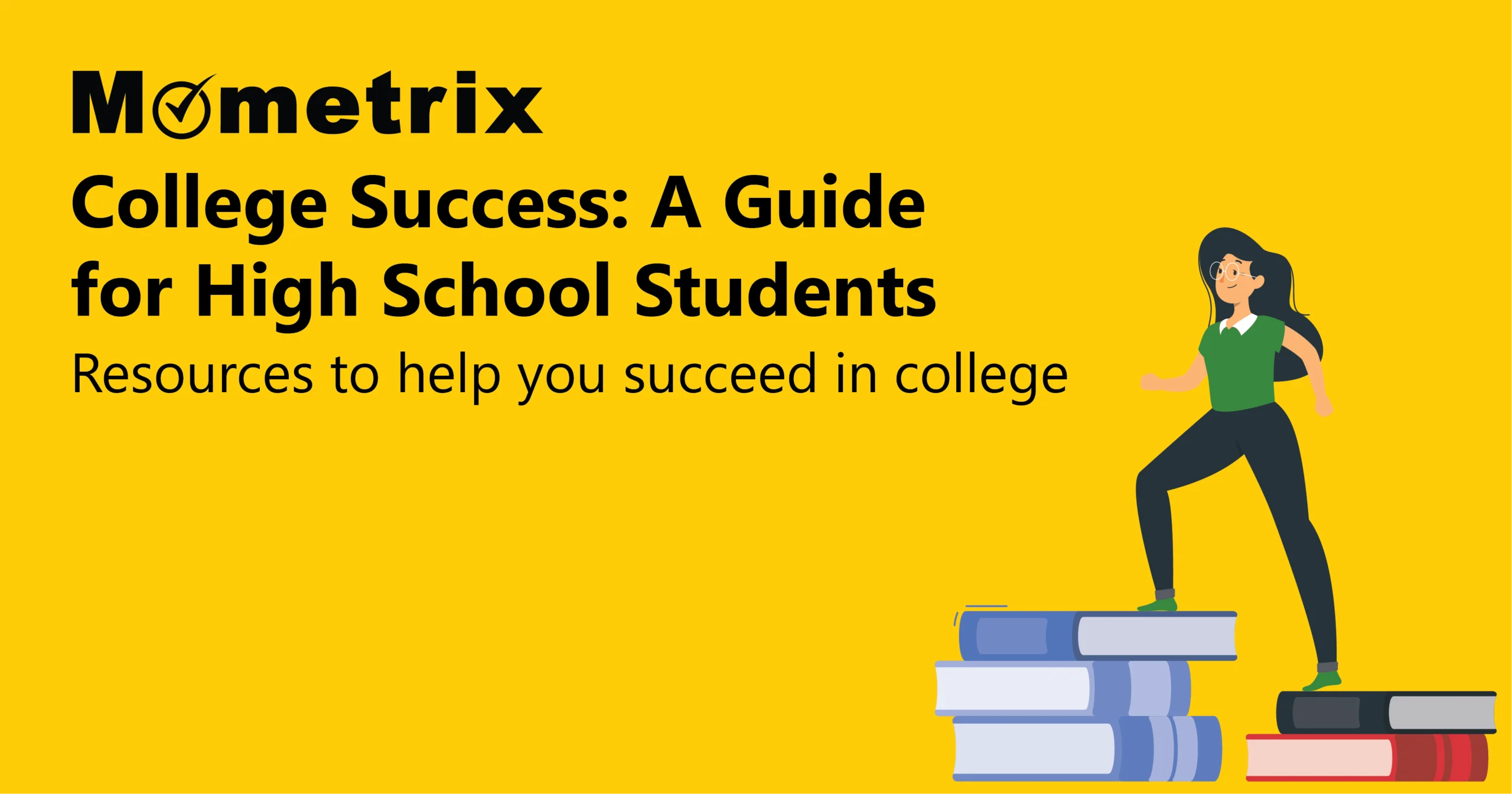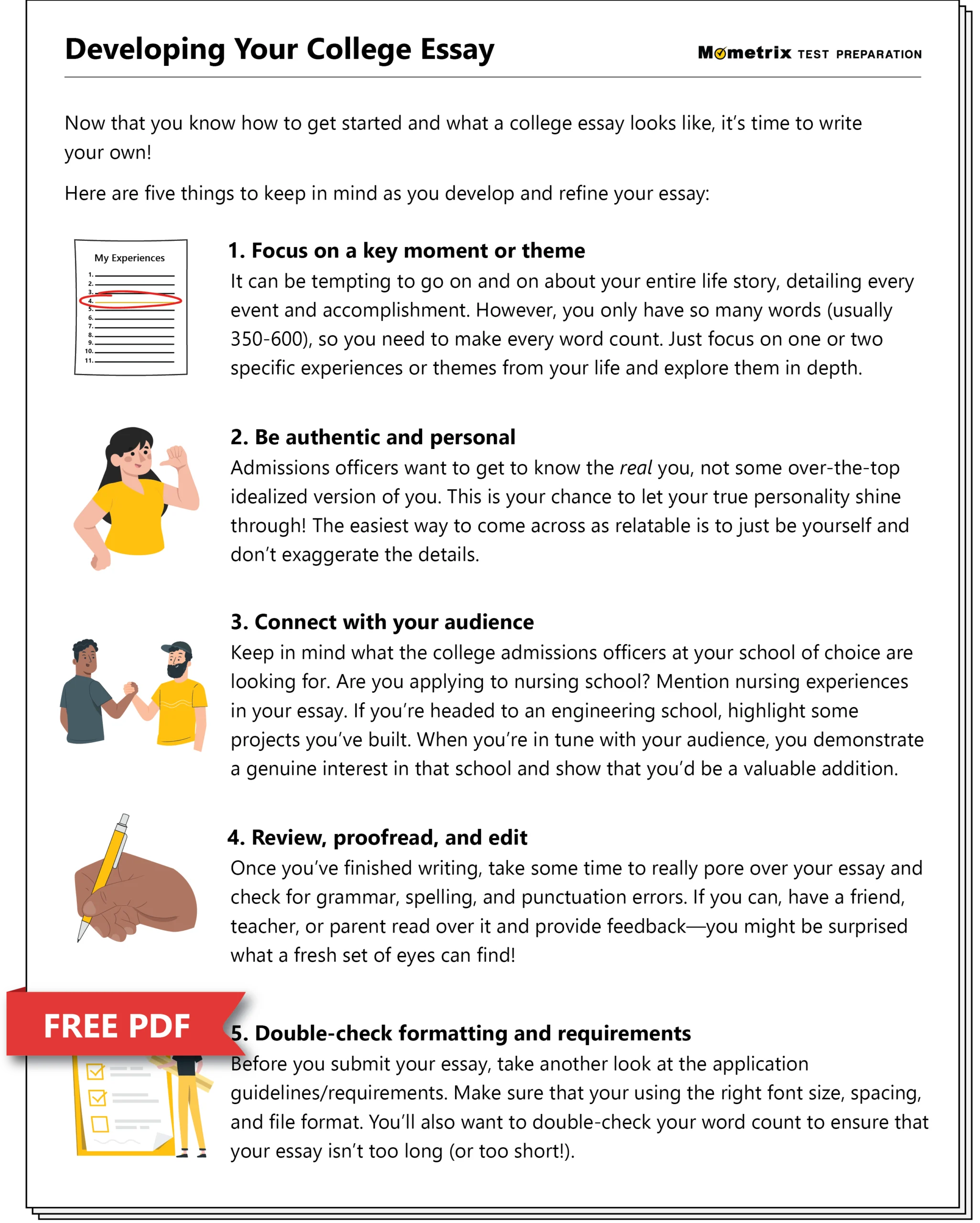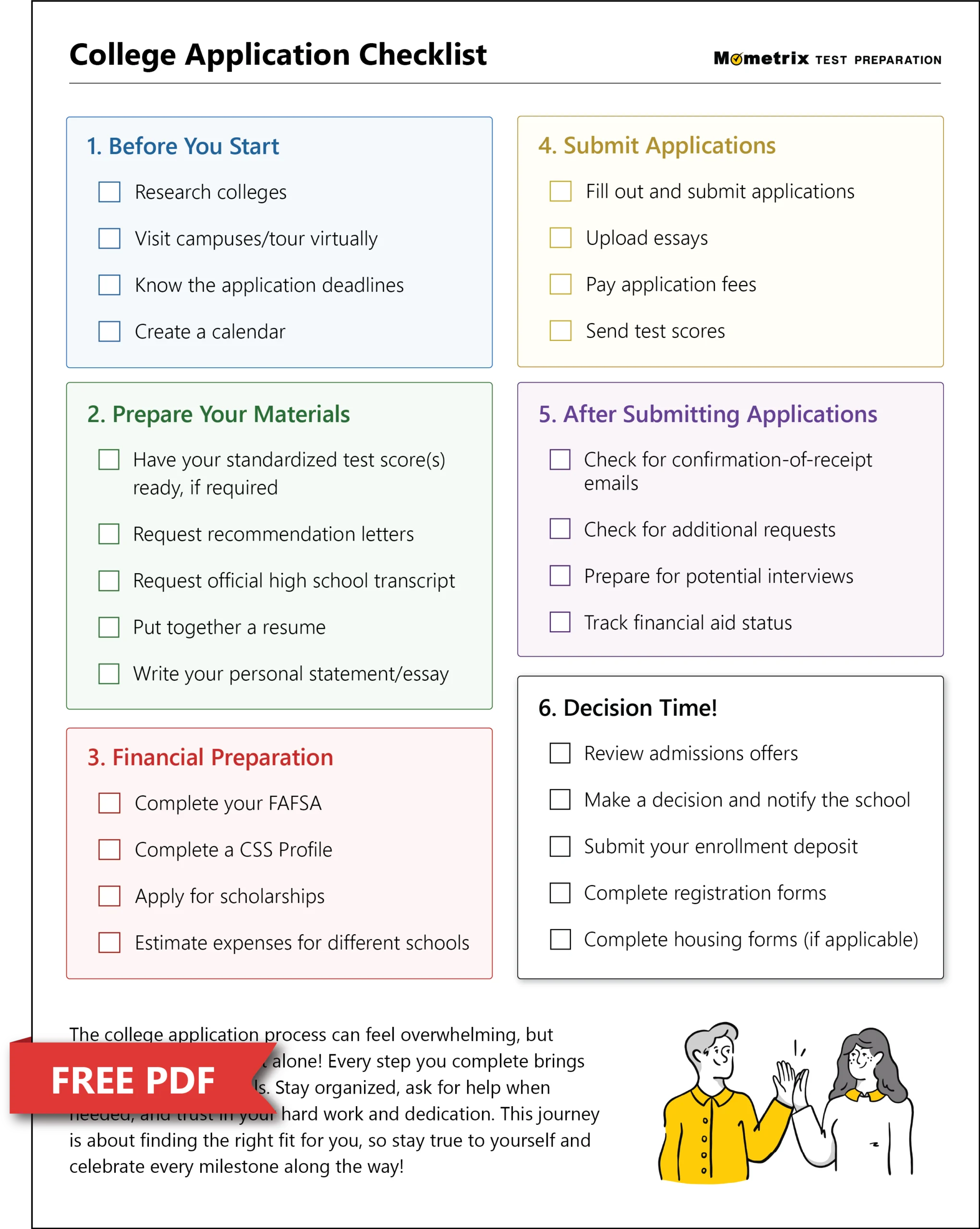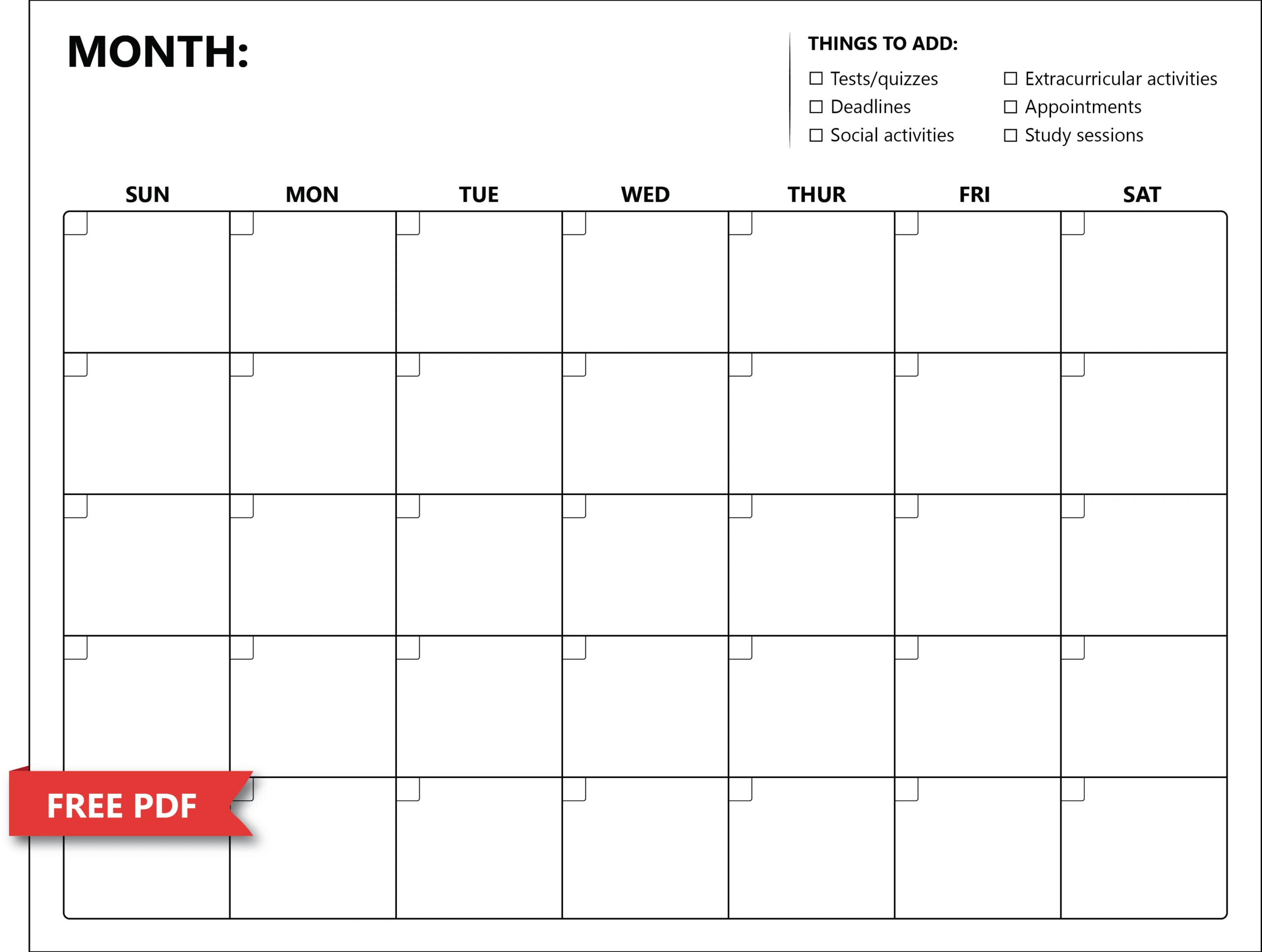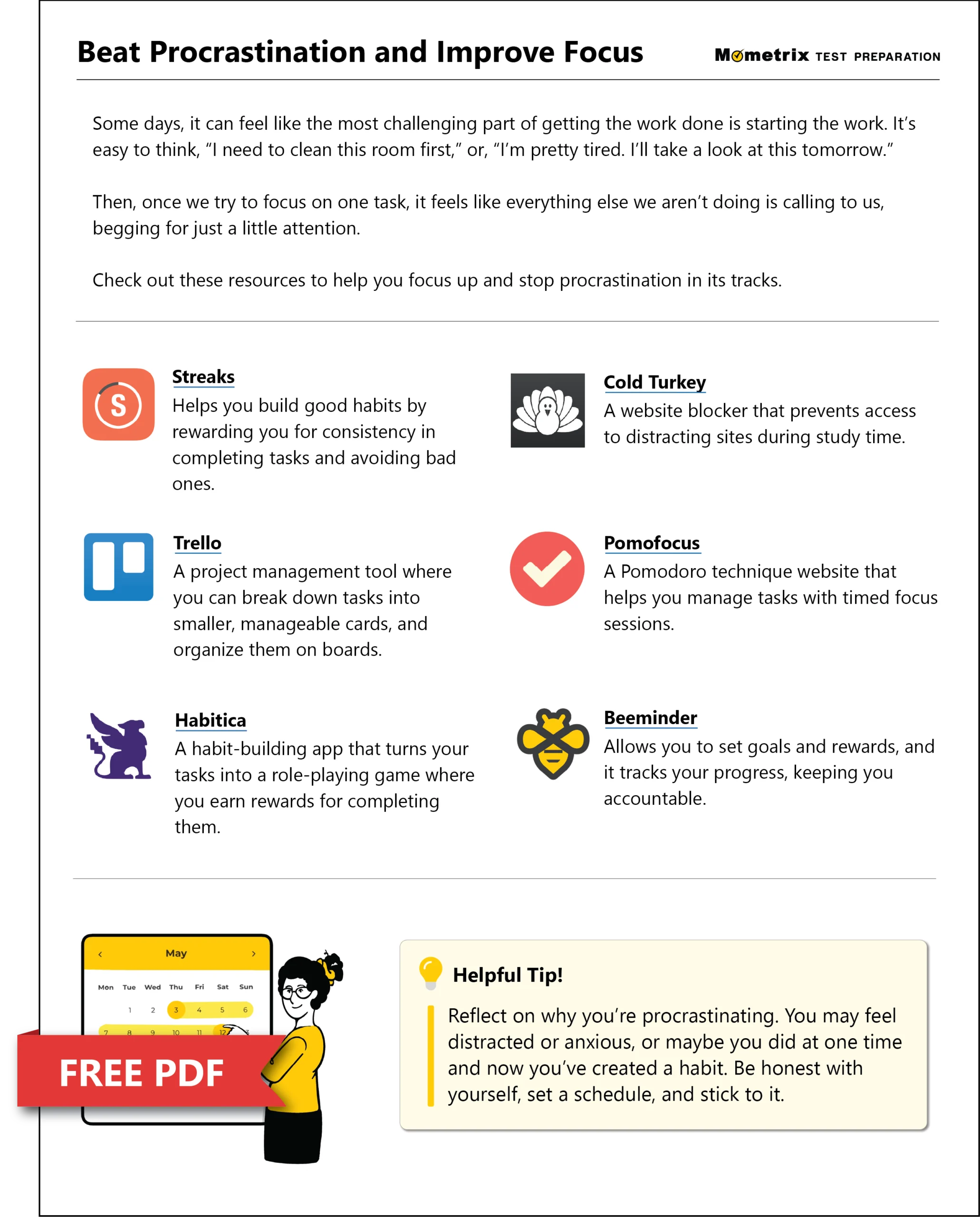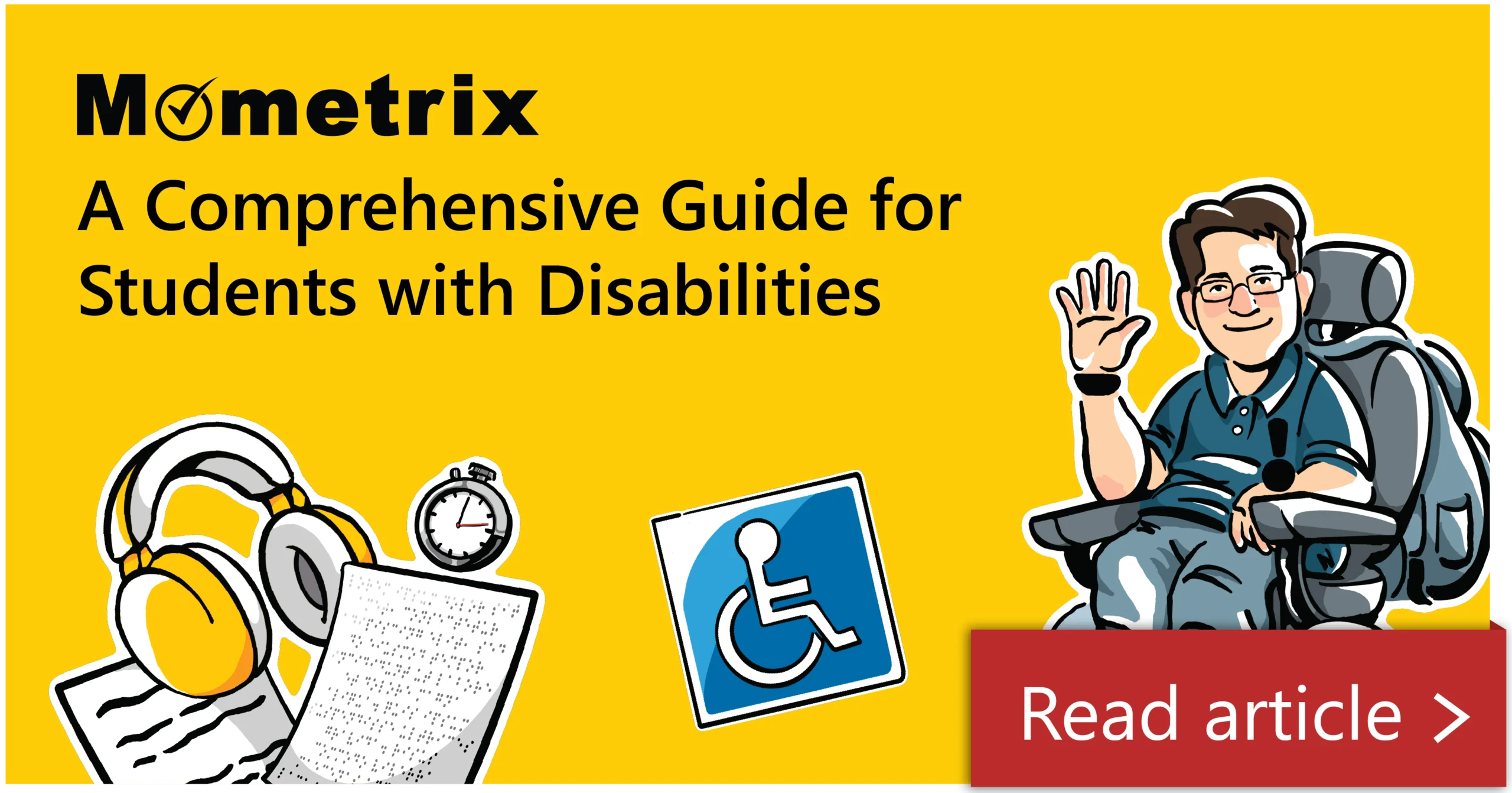As you finish up your final years of high school, the college application process looms closer and closer—and it can start to feel overwhelming.
While it’s definitely a big deal, there are many tools, resources, and tips you can use to turn this from a daunting chore into an exciting opportunity!
We’ve put together these resources into a single “toolkit,” so you can tackle your education head-on with all the tools you need to succeed.
Acing Your College Application
The college application process can seem daunting, but with careful planning and execution, you can significantly increase your chances of getting accepted to your dream school.
Let’s break down the process and establish some actionable steps to make your application stand out.
Understanding the College Application Process
The college application process typically involves several key components:
Your high school transcript lists all the courses you’ve taken and the grades you’ve received throughout high school. It provides colleges with a comprehensive view of your academic performance.Standardized Test Scores
Many colleges require you to submit scores from standardized tests like the SAT or ACT. These tests assess your skills in general areas, like reading, writing, and math.
Letters of Recommendation
These letters are written by teachers, counselors, or other individuals who can speak to your character, academic abilities, and extracurricular involvement. They provide a third-party perspective on your potential for success in college.
Personal Essay
If one is required, the personal essay is your opportunity to showcase your personality, writing skills, and unique experiences. It lets you tell your story and explain why you’re a good fit for the college.
If you need help getting started on your essay, check out this free essay-writing guide:
Extracurricular Activities
Your involvement in extracurricular activities demonstrates your interests, passions, and commitment outside of the classroom. Colleges look for well-rounded individuals who are actively engaged in their communities.
Application Forms
Each college has its own application form that you’ll need to complete. These forms typically ask for basic information about yourself, your family, and your academic background.
What College Admissions Officers Look For
College admissions officers take a holistic approach when evaluating applications. They consider various factors, including:
Your grades and test scores are important indicators of your academic ability and potential for success in college-level coursework.Intellectual Curiosity
Colleges seek students who are eager to learn and explore new ideas. Your essay and letters of recommendation can help demonstrate your intellectual curiosity.Personal Qualities
Admissions officers look for students who are mature, responsible, and resilient. They want to admit individuals who will contribute positively to the campus community.
Extracurricular Involvement
Your participation in extracurricular activities shows that you’re well-rounded and have a variety of interests. Colleges value students who are actively involved in their school and community.
Fit
Colleges want to admit students who are a good fit for their institution. This means considering your academic interests, personal values, and overall goals.
Crafting a Stellar Application
To make your application stand out, consider the following tips:
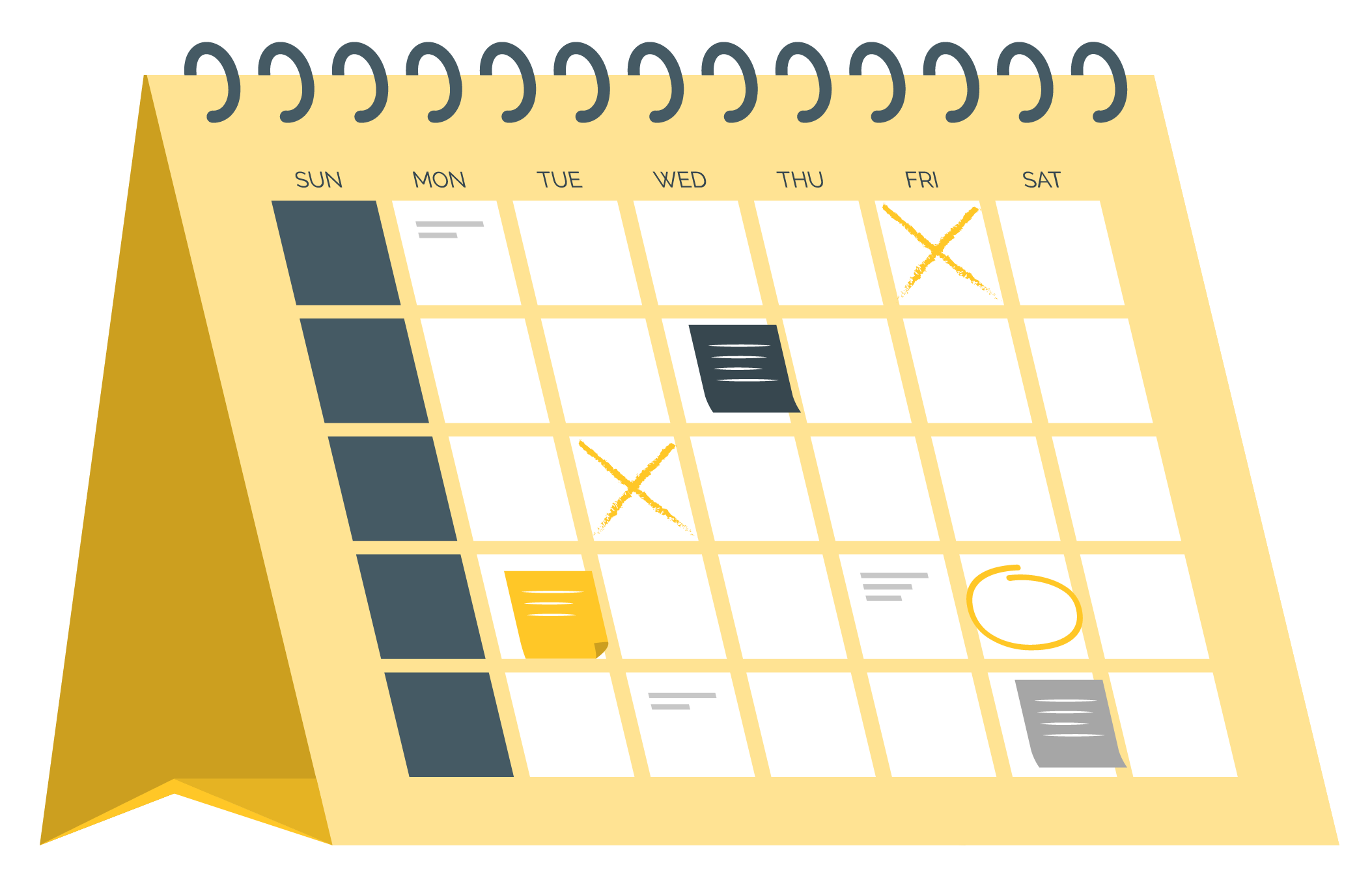
Start Early
Don’t wait until the last minute to start your application. Begin the process early so you have plenty of time to gather materials, write essays, and request letters of recommendation.
Highlight Your Strengths
Think about the achievements you’re most proud of, the challenges you’ve overcome, and the qualities that define who you are. Use your essay and extracurricular activities to showcase your talents and passions.

Be Authentic
Don’t try to be someone you’re not. Admissions officers can tell when someone is trying too hard to impress. Share your real experiences and insights, even if they’re not grand or dramatic.

Tailor Your Application
If you’re applying to multiple schools, don’t just copy and paste your application for every school. Customize each one to reflect the programs and values of each school, and try to use the school’s language if possible.

Proofread
Errors in grammar and spelling can make a negative impression. If you proofread your application materials carefully before submitting them, you’ll come across as more professional and easier to understand.

Seek Feedback
Ask trusted teachers, counselors, or mentors to review your application materials and provide feedback. They can help you fine-tune your essay, highlight overlooked strengths, and ensure your application aligns with your goals.
Maintaining a Positive Digital Footprint
In today’s digital age, it’s important to be mindful of your online presence. College admissions officers may search for you online, so make sure your social media profiles and other online content reflect positively on you.
- Review Your Privacy Settings: Make sure your social media profiles are set to private or that you’re comfortable with the content being seen by college admissions officers.
- Google Yourself: See what comes up when you search for your name online. If you find anything negative, take steps to remove it or address it.
- Be Mindful of What You Post: In general, avoid posting anything online that you wouldn’t want a college admissions officer to see.
College Application Checklist
By following these tips and putting your best foot forward, you can significantly increase your chances of getting accepted to the college of your dreams.
Remember, the college application process is a marathon, not a sprint. Take your time, stay organized, and don’t be afraid to ask for help along the way.
To help you keep track of the steps involved in the application process, check out this college application checklist!
Important Dates for Standardized Tests
Taking the SAT, ACT, or some other standardized test is often one of the biggest steps you can take to further your education and career.
Some tests have testing dates available throughout the year, while others only administer the test during specific windows.
For example, these are the upcoming test dates for the SAT and ACT:
| SAT Test Dates |
|---|
| November 8, 2025 |
| December 6, 2025 |
| March 14, 2026 |
| May 2, 2026 |
| June 6, 2026 |
| ACT Test Dates |
|---|
| December 13, 2025 |
| February 14, 2026 |
| April 11, 2026 |
| June 13, 2026 |
| July 11, 2026 |
Planning Ahead
Whichever test(s) you take, be sure you know when the testing dates are and plan ahead accordingly.
You never know what might pop up—you may get sick, have an unexpected commitment, or not get the score you wanted on your first try. Consider taking the test earlier to give you enough time to retake the test if needed.
Also, keep in mind that there are usually registration deadlines to keep track of, and you might have to pay a fee if you register late.
Getting Your Test Scores
After you take a test, the first thing you want to know is if you passed! For some tests, you’ll know if you passed immediately after taking it. For others, it may take anywhere from a few days to a few weeks before you know your final score.
For both the SAT and ACT, you should get your scores about 2 to 4 weeks after you take the test.
Choosing a Major and Career Path
Choosing a major and career path is a significant decision that will shape your future.
There’s a lot at stake, but it doesn’t have to be overwhelming.
To help you navigate this process and explore various options, we’ve put together a roadmap that includes traditional college paths and alternative routes like trade schools.
Timeline
There’s no one-size-fits-all answer to when you should choose a major and career path.
Just to give you an idea, here’s a general timeline:
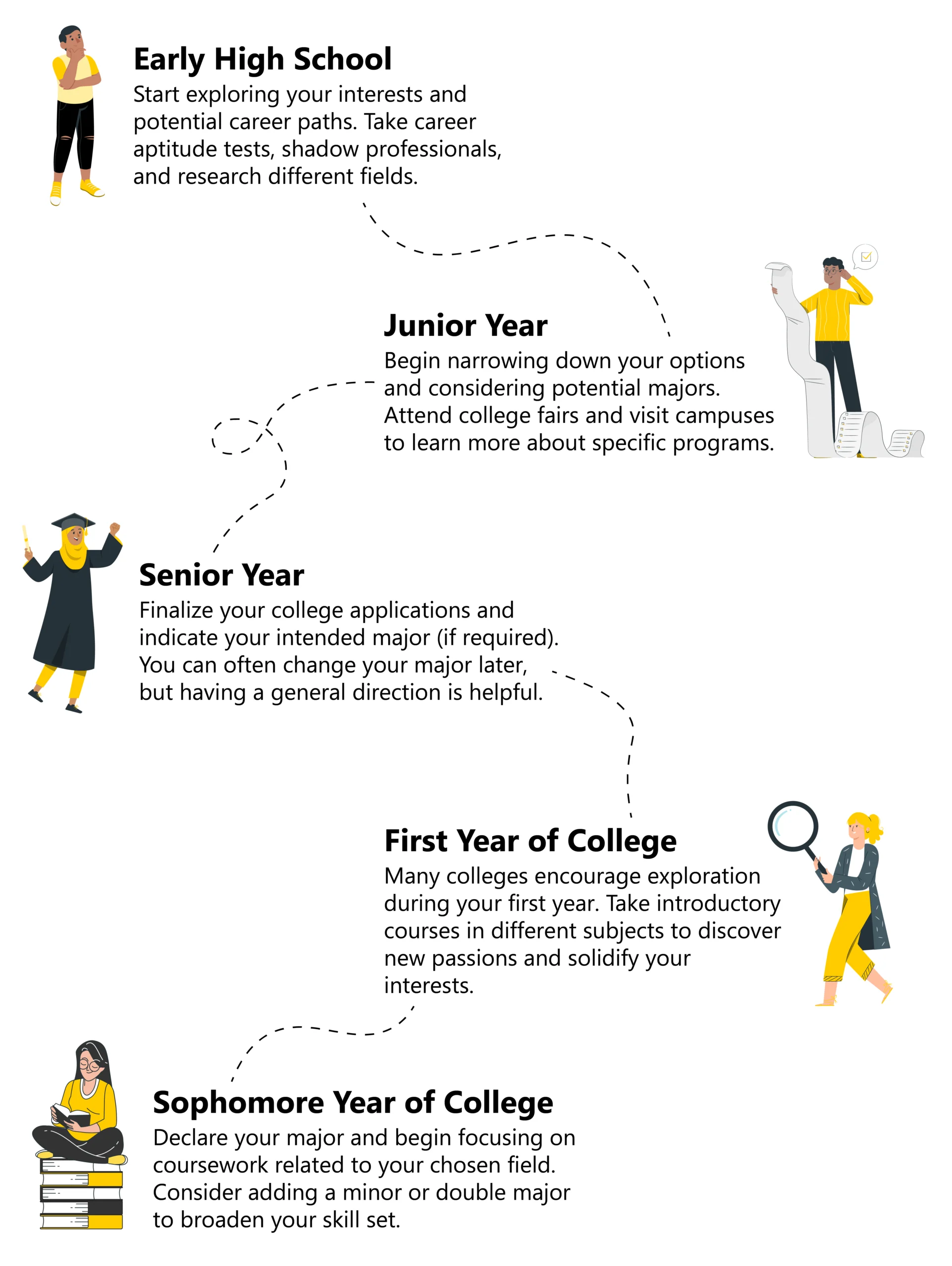
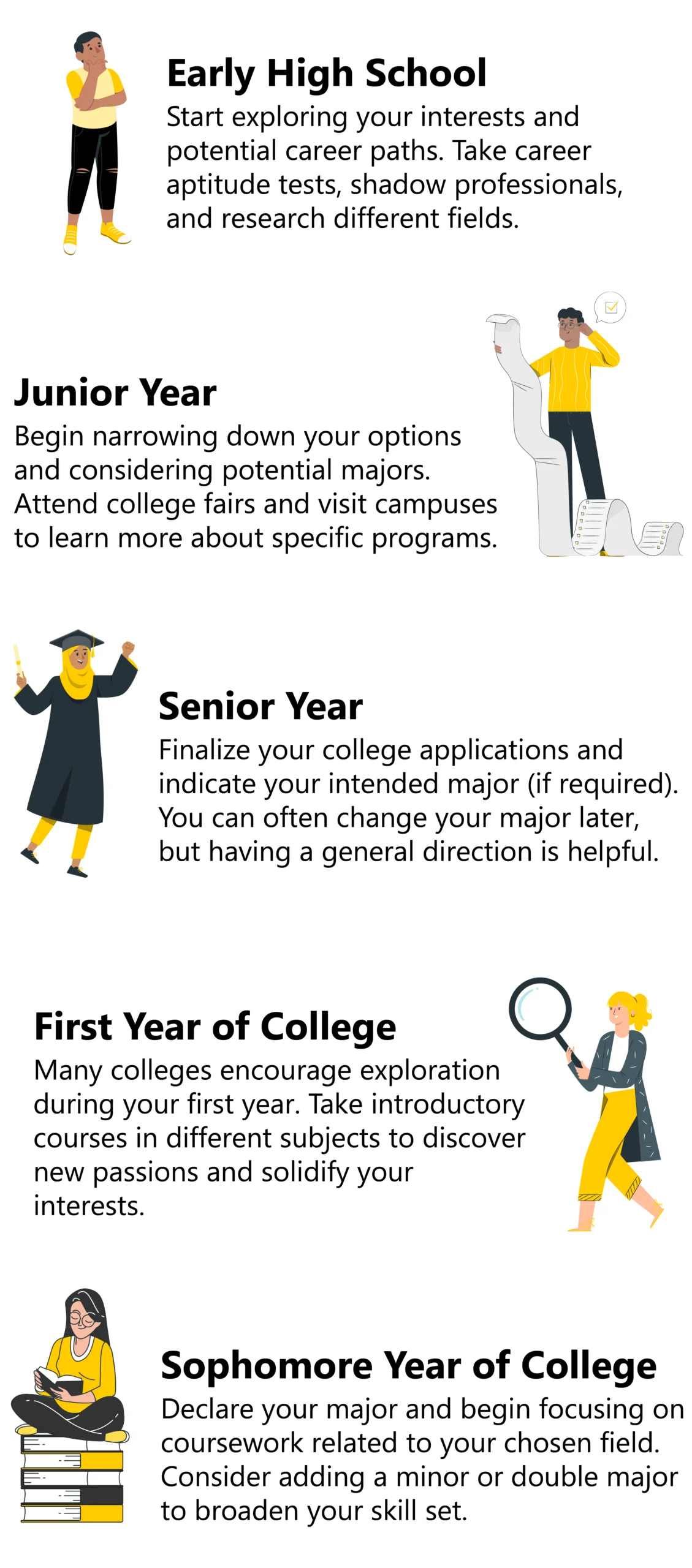
Some students enter college with a clear idea of what they want to study, while others take time to explore their options.
Here are some things you should keep in mind:
- Interests and Passions: What are you genuinely interested in? What subjects do you enjoy learning about? Aligning your major with your passions can lead to a more fulfilling career.
- Strengths and Skills: What are you good at? What skills do you possess? Consider how your strengths can translate into a successful career.
- Values: What’s important to you in a career? Do you prioritize work-life balance, helping others, creativity, or financial security?
- Career Goals: What kind of career do you envision for yourself? Research different career paths and the required education and skills.
- Market Demand: Consider the job market and the demand for specific skills and professions. Choose a field with growth potential.
Exploring Different Paths
While a traditional four-year college is a common path, it’s not the only option! Here are some different paths to consider:

Four-Year College/University
This traditional route offers a wide range of majors and opportunities for personal and intellectual growth. It typically leads to a bachelor’s degree, which is often required for many professional careers.

Community College
Community colleges offer a more affordable and accessible option for higher education. You can earn an associate’s degree or transfer credits to a four-year college.

Trade Schools
Trade schools provide specialized training in specific trades, such as carpentry, plumbing, or welding. They offer a faster and more hands-on approach to career preparation.

GED Programs
If you didn’t complete high school, obtaining a GED certificate can open doors to further education and career opportunities. Many community colleges and trade schools accept GED holders.

Apprenticeships
Apprenticeships combine on-the-job training with classroom instruction, allowing you to earn while you learn a skilled trade.

Online Learning
Online courses and degree programs offer flexibility and convenience, allowing you to learn at your own pace and on your own schedule.
Trade Schools
Trade schools offer a practical and efficient path to a skilled trade. Here are some popular trade school options and their potential average salaries:

Electrician | $60,040
Electricians install and maintain electrical systems in buildings and infrastructure. Every state has different requirements, so you might spend anywhere from 6 months to 5+ years in school before acquiring a license.

Plumber | $59,880
Plumbers install and repair the water and drainage systems in residential and commercial buildings. You’ll generally spend about 4 to 5 years in school before acquiring a license.

HVAC Technician | $50,590
HVAC technicians install, maintain, and repair heating, ventilation, and air conditioning systems. Every state has different requirements, but you’ll likely spend 6 months to 3 years in school before acquiring a license.
Welder | $46,150
Welders use specialized equipment to join metal parts together. Every state has different requirements, but you’ll likely spend 6 months to 2 years in school before acquiring a license.

Carpenter | $49,520
Carpenters construct and repair building frameworks and structures. Every state has different requirements, but you’ll likely spend 1 to 4 years in school before acquiring a license.
Note: These salaries are averages and can vary depending on location, experience, and industry.
Make the Most of the Path You Choose
No matter which path you choose, remember to do your research, ask questions, and build as many connections as you can.
It’s also very important that you are open to change. Your interests and goals may change over time, so you should be flexible and willing to adjust your path as needed.
By taking the time to explore your options, consider your goals, and seek guidance, you can make informed decisions and embark on a fulfilling career path.
Transitioning to College Life
College is a time of growth, learning, and self-discovery. But with so much change happening all at once, it’s natural to feel both excited and apprehensive.
Here are some things to keep in mind regarding what to expect during this transition, including tips and insights to help you thrive in your new environment.
Academic Expectations
College academics often differ significantly from high school. Here’s what you need to know:
Increased Responsibility

In college, you’re treated like an independent adult—because you are one! This means that professors expect you to take charge of your learning. It’s totally up to you to show up to class, keep track of assignments and deadlines, and manage your time wisely.
No one will be checking in on you or reminding you about due dates and homework.
This newfound freedom is exciting, but you have to really be organized and on top of your work. You’re responsible for your own success!
Faster Pace and Deeper Dive
Buckle up! You’re going to learn a LOT of information in a short amount of time.
College courses tend to go over material a lot faster than high school classes, and they usually go into greater depth. You’ll be challenged to analyze information, take great notes, think critically, and form your own opinions and arguments.
You also need to be prepared to take on more complex reading assignments, participate in in-depth discussions, and tackle tricky assignments.
Active Learning

Depending on your major/focus of study, college courses are designed to get you actively involved in the learning process. For instance, your professors might use lectures, group discussions, and hands-on projects to help you grasp the material.
Be prepared to participate in class, share your thoughts and ideas, and engage with the content you’re learning about.
Even if your courses don’t have an active learning element, it’s a good idea to use active learning on your own to deepen your understanding of the information.
Seeking Help
Yes, you’re an independent adult, but even adults need a little help sometimes!
College is no exception here. Don’t be afraid to ask for help when you need it. Your professors and the other school staff are there to support you, and they usually have specific office hours available for students to drop in and ask questions.
Your college will likely have various resources like writing labs and tutoring centers, which you should take advantage of.
Social Life and Building Connections
College offers a unique opportunity to meet people from diverse backgrounds and forge lasting friendships. Here’s how to navigate the social scene:
Be Open to New Experiences

College isn’t just for going to class and studying—it’s also about exploring new things and meeting new people!
Don’t be afraid to step outside of your comfort zone. Join a club that sounds vaguely interesting, even if it’s not something you know much about. Attend campus events, even if you don’t know anybody else there.
Also, don’t hesitate to strike up conversations with your classmates (preferably not during class). You might be surprised at the connections you can make and the friendships you can form.
Embrace Diversity
Part of exploring new things and meeting new people is getting to experience the incredible diversity of the people around you. You’re likely to encounter students from all walks of life, with different cultures, beliefs, and backgrounds.
It’s important to be open-minded and respectful of these differences.
This is also a perfect opportunity to learn from your peers, appreciate other people’s perspectives, and broaden your own perspective.
Find Your Crowd

Within the diverse variety of people on campus, you’re almost guaranteed to find others who share your interests.
This is where joining clubs and attending events comes in handy—these are easy ways to meet new people. Whether you’re passionate about music, sports, politics, or gaming, there’s likely a group of people who are waiting for someone cool like you to show up!
Balance Social Life and Academics
While socializing and making friends is important, it’s also important to find the balance between your social life and your academics. Remember, you’re ultimately here to learn!
Make sure you’re dedicating enough time to your studies, attending classes, and completing your assignments (on time). If you plan and prioritize accordingly, you’ll be set to enjoy an active social life while still achieving your academic goals.
Living On or Off Campus
Whether you choose to live in a dorm or off-campus, there are adjustments to be made:
Dorm Life
- Community Living: Dorm life offers a built-in community and opportunities for socializing. Be prepared to share your space and respect your roommate’s needs.
- Amenities and Resources: Most dorms provide amenities like laundry facilities, common areas, and resident assistants (RAs) who can help with any issues.
- Rules and Regulations: Dorms have specific rules regarding quiet hours, guests, and safety. Familiarize yourself with these policies.
Off-Campus Living
- Increased Independence: Living off-campus offers greater independence but also comes with added responsibilities like paying rent, utilities, and groceries.
- Finding Roommates: Carefully choose roommates who are compatible with your lifestyle and values.
- Commuting: Factor in commute time to campus and consider transportation options.
Managing Your Time and Finances
College life requires effective time management and financial responsibility. Here’s what you should do to keep yourself on track:
Create a Schedule
Don’t try to keep your schedule in your head—write it down!
There are all sorts of ways to keep track of your schedule and commitments. You can use a planner, a calendar app, or even a whiteboard to visualize things on a bigger scale.
Take note of all your classes and assignments, but don’t stop there. Also write down your extracurricular activities, social events, and other commitments and appointments you may have. It’s important to know exactly how your time is expected to be spent.
A well-structured schedule will help you stay organized, reduce stress, and ensure you don’t miss deadlines.
If you need some help getting started, check out this printable schedule!
Prioritize Tasks
Not all tasks are created equal. You’ll need to identify the most important assignments and due dates and ensure those are attended to first.
To help you knock out these bigger tasks, like research papers or presentations, try breaking them down into smaller pieces. This will also make things less daunting and allows you to make consistent progress.
When you break things down, it’s helpful to have a to-do list to keep track of all the smaller pieces and check them off as you go.
Avoid Procrastination

Let’s face it—who hasn’t procrastinated at least once in their lives? It’s an easy trap to fall into, but know that procrastination is your enemy in college.
Putting off assignments until the last minute can lead to rushed work and increased stress, and you’re likely to get lower grades.
Make it a goal to combat procrastination. Find a quiet study space, set time limits for tasks, reward yourself for completing work on time, and try to tackle assignments early. Not leaving things until the last minute gives you plenty of time to review, revise, and seek help if needed.
If you need some help getting started, check out these resources designed to help you improve your focus and beat procrastination:
Budgeting

It may seem like the most boring and tedious thing in the world, but creating a budget is the best way to start building good financial habits. There are plenty of budgeting apps and templates out there to help you get started.
The basics of a budget are your income and expenses, so start by writing down how much money you’re making and how much you’re spending. Then, try categorizing your spending into needs, wants, and savings. This will give you a clear picture of where your money is going and where you might need to cut back.
Financial Aid/Student Loans
Speaking of spending money, understanding your financial aid/loan details is crucial. Don’t hesitate to ask the financial aid office for guidance—that’s why they’re there!
Before you take out a loan, explore some alternatives like work-study programs to help minimize debt. If you do end up taking out loans, focus on federal loans first. They have lower interest rates and usually have better repayment options than private loans.
If you take the time to fully understand your financial aid now, it will save you from several headaches later.
Taking Care of Your Well-Being
College can be demanding, so prioritizing your physical and mental health is crucial:
Healthy Habits

Creating healthy habits early on is essential.
Be mindful of what you’re putting into your body, and try to keep a balanced diet that keeps you healthy and energized. Fruits, vegetables, whole grains, and lean proteins will help fuel your body and mind, and staying hydrated is a must.
Regular exercise, even just 30 minutes of walking a day, can boost energy, improve focus, and reduce stress. If you’re not into walking, yoga is a great alternative.
Sleep is equally important—if you’re not getting enough sleep, your mind and body aren’t able to recover and prepare for the next day.
Stress Management
It’s no surprise that college can be a stressful experience, but there are ways you can manage your stress so you don’t become overwhelmed.
Practicing mindfulness is a great place to start. This includes things like meditation or deep-breathing exercises to help you stay grounded. It can also help to journal your thoughts or confide in a friend about your worries/stresses.
Spending time in nature can provide a refreshing break as well, whether you take a walk in the park, ride your bike around campus, or just sit in the grass and enjoy the breeze. Hobbies or creative outlets like music, drawing, or sports are also excellent ways to unwind and take your mind off things.
Mental Health Resources
Keeping up with your mental health is just as important as your physical health, and recognizing when you need help is a strength, not a weakness.
Many colleges offer free or low-cost counseling, which can include therapy, support groups, and/or workshops. Some colleges provide apps or hotlines for anonymous support as well.
If you ever experience persistent anxiety or depression or find yourself extremely overwhelmed, don’t hesitate to seek professional assistance. Addressing mental health concerns early can prevent larger challenges and equip you to succeed in your academics and in your personal life.
Seek Support

Part of maintaining your mental health is learning to rely on your support network—no one has to navigate the challenges of college alone.
Your support network includes your friends and family, but it can also include your professors or other mentors. These are people who you can share your concerns with and seek advice from when you’re facing a difficult situation.
Remember, reaching out is not a sign of weakness or giving up. It’s a step toward resilience. Support systems not only help you through tough times, but they also celebrate your success.
Embracing the College Experience
College is a time of tremendous growth and exploration. Here are some tips to make the most of it:
- Get Involved: Participate in extracurricular activities, clubs, and organizations that interest you.
- Explore Your Interests: Take classes outside your major to broaden your horizons and discover new passions.
- Study Abroad: Consider studying abroad to experience different cultures and gain a global perspective.
- Network: Attend career fairs, connect with alumni, and build relationships with professors.
- Embrace Challenges: College will present challenges, but view them as opportunities for growth and learning.
Financial Aid and Scholarships
College is a significant investment, but don’t let the cost deter you from pursuing your dreams. Financial aid and scholarships can make higher education more affordable.
Let’s take a closer look at the process and get some insights into the typical costs of college.
What is Financial Aid?
Financial aid is money you can receive to help pay for college. It can come from various sources, including the federal government, state governments, colleges and universities, and private organizations.
Types of Financial Aid
Financial aid can be in the form of grants, scholarships, loans, and work-study programs.

Grants
Financial aid you don’t repay, often based on financial need or special criteria. Examples include Pell Grants and institutional grants from colleges.

Scholarships
Merit- or need-based awards for academic, athletic, or other achievements. Scholarships often require maintaining eligibility standards and don’t need to be repaid.

Loans
Borrowed money for college expenses. Federal and private loans must be repaid with interest after graduation or dropping below part-time enrollment.

Work-Study
Part-time jobs for students with financial need. Earnings help cover educational costs, and jobs are often on-campus or related to your field of study.
How Much Does College Cost?
The cost of college varies depending on the type of institution (public or private), whether you attend in-state or out-of-state, and your living expenses. Here’s a general idea of the average costs for the 2023-2024 academic year:
- Public two-year college (in-state): $3,800
- Public four-year college (in-state): $10,940
- Public four-year college (out-of-state): $28,240
- Private four-year college: $39,400
Keep in mind that these are just averages. Your actual costs may be higher or lower.
What is the Financial Aid Process?
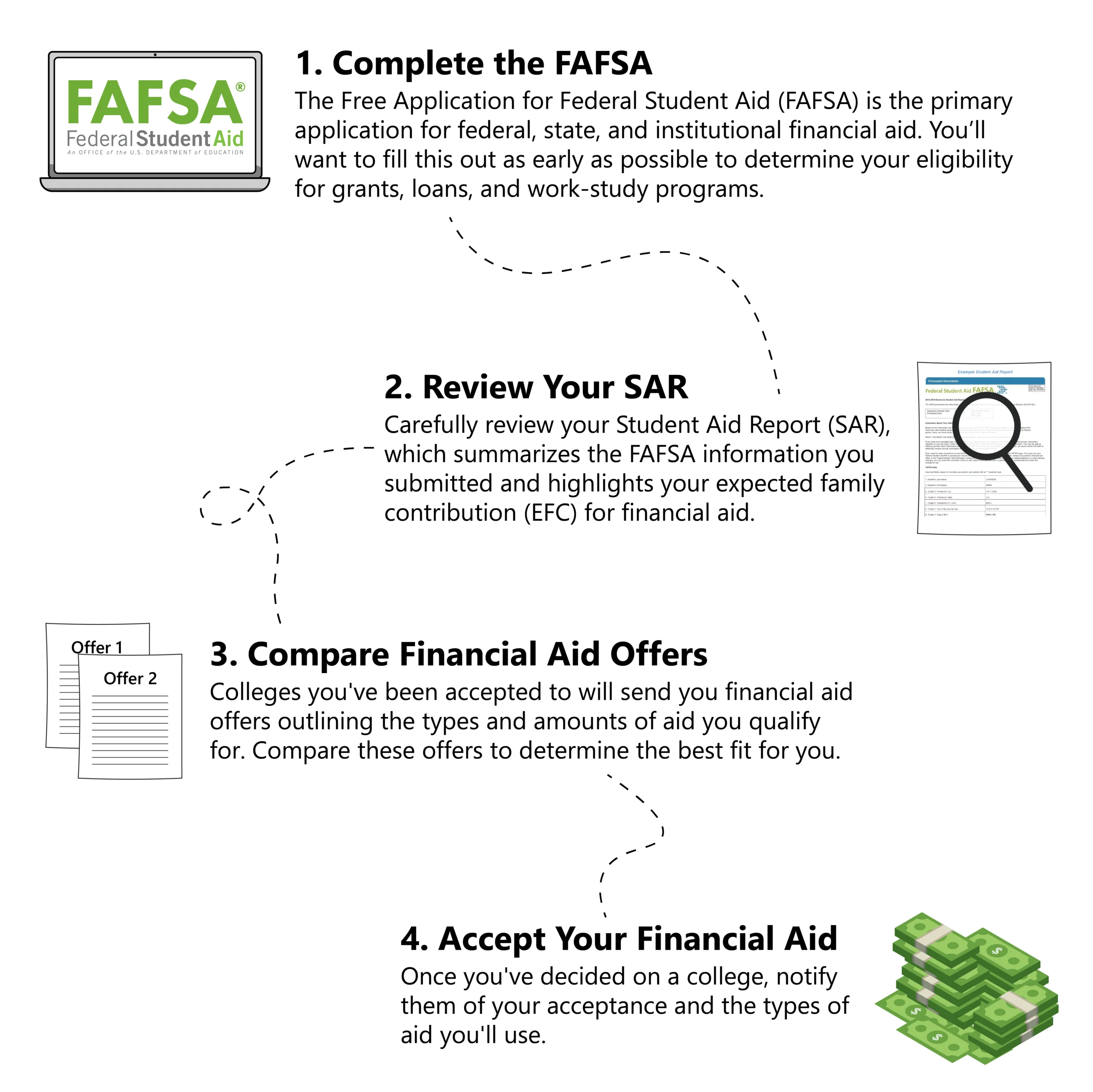
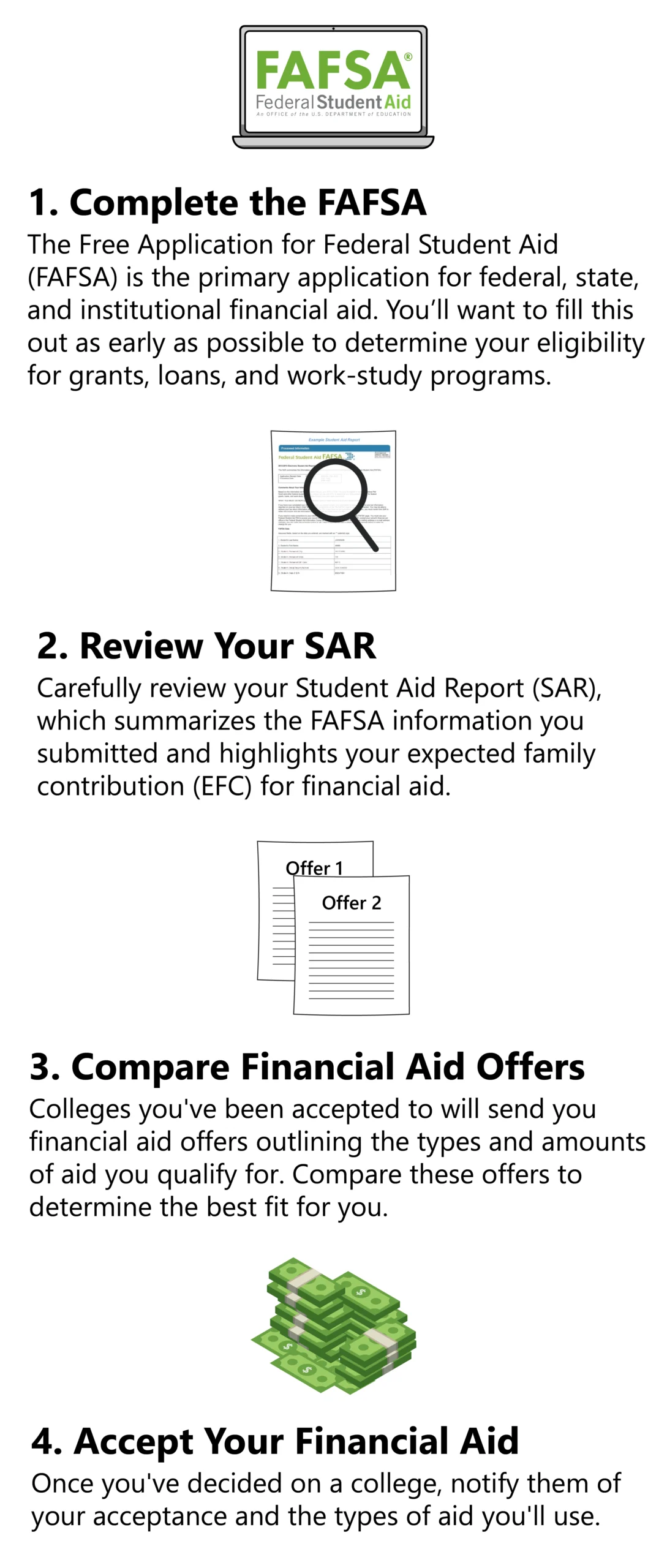
Top 15 Places to Apply for Scholarships
Here are some of the best places to search for scholarships:
- Federal Student Aid: The US Department of Education offers various grants, loans, and work-study programs. Start your search at studentaid.gov.
- Your State Grant Agency: Each state has its own grant agency that offers financial aid to residents. Contact your state’s higher education agency for more information.
- Your College or University: Most colleges and universities offer scholarships to their students. Check with the financial aid office at your chosen institution.
- Fastweb: A comprehensive scholarship search engine with a database of over 1.5 million scholarships.
- Cappex: Another popular scholarship search engine that matches you with scholarships based on your profile.
- Scholarships.com: A free scholarship search platform with a large database of scholarships.
- Unigo: A website that offers a scholarship search engine, college matching tools, and financial aid advice.
- Peterson’s: A resource for college planning, test preparation, and scholarship searches.
- College Board: The organization behind the SAT offers a scholarship search tool and resources for college planning.
- Mometrix: Mometrix offers annual scholarships and has a great test prep library to help students succeed.
- BigFuture: The College Board’s website provides a scholarship search tool and other college planning resources.
- Niche: A website that provides rankings and reviews of colleges, as well as a scholarship search tool.
- Scholly: A mobile app that helps you find and apply for scholarships.
- RaiseMe: A platform that allows you to earn micro-scholarships for your achievements in high school.
- Local Organizations and Businesses: Check with local community organizations, businesses, and civic groups for scholarship opportunities.
For even more scholarship opportunities, check out this comprehensive list of scholarship resources:
Tips for Applying to Scholarships
- Start Early: The earlier you start your scholarship search, the better your chances of success.
- Create a Scholarship Profile: Keep track of your academic achievements, extracurricular activities, and community involvement to make applying for scholarships easier.
- Tailor Your Applications: Personalize each scholarship application to match the specific criteria and requirements.
- Proofread Carefully: Ensure your applications are free of errors and typos.
- Don’t Give Up: Applying for scholarships can be time-consuming, but the rewards can be significant.
Check out this downloadable scholarship tracker to help you keep tabs on which scholarships you’ve applied for!
Studying Abroad
Studying abroad can be an incredible opportunity to immerse yourself in a different culture and make memories that will last a lifetime while you advance your educational goals.
There’s a lot involved with studying abroad, so let’s take a look at the pros and cons and what you can expect.
Why Study Abroad?
Cultural Immersion

Surrounding yourself with a new culture means getting to experience different foods, traditions, languages, and ways of life, which can broaden your understanding of the world. You’ll also gain a new perspective on global issues that you might not have thought much about before.
Personal Development
As you gain a new perspective on things and navigate a new environment, you’ll boost your self-confidence, social skills, independence, and overall resilience. You may even find new hobbies and activities that you enjoy and can share with your friends back home.
Academic Advancement
Some programs offer specialized courses and assignments that aren’t available where you live! For instance, if you’re studying art history, you can get an invaluable first-hand look at famous artworks in France or Italy. If you’re studying linguistics, you’ll get to practice conversing with native speakers in real-life situations, which will deepen your understanding of the language.
Career Advancement
If you take the time to expand your network and connect with people, you may open doors to international career opportunities. If working abroad isn’t for you, there are plenty of employers back home who are looking for people with experience in other countries!
Some Things to Consider
While studying abroad is an exciting opportunity, there are some things to take into account:
- Homesickness: Being away from home can be challenging, especially if you don’t have much prior traveling experience.
- Costs: Studying abroad can be expensive, and not all schools or families have the resources to support it.
- Cultural Adjustment: Adjusting to a different culture may be difficult, and language barriers may be too large of a hurdle to overcome.
- Academic Challenges: Different teaching styles and a heavier and fast-paced workload might affect your usual learning groove and require some adjustment.
Majors and Courses That Often Include Studying Abroad
Students from any major can generally study abroad, but there are some fields that often incorporate international studying directly into the curriculum:

International Relations
What better way to understand global issues and diplomacy than first-hand experience in another country?

Foreign Languages
Immersing yourself in the language and culture you’re studying is essential for achieving fluency.

Anthropology
Conducting fieldwork and engaging with different cultures can help you gain a better understanding of human behavior.

Political Science
Studying abroad will allow you to see different political systems in action, as well as their effects on society.

Art/Art History
As mentioned earlier, getting to see historical artworks and their related cultures first-hand is an invaluable experience.

Business
Seeing the inside of business operations in other countries can help you gain a global perspective on business practices (and expand your network!).
How Much Does Studying Abroad Cost?
Studying abroad comes with costs, and it’s important to plan ahead. Here’s a breakdown of some typical expenses:
- Program Fees: Programs vary widely in cost. Some are as low as a few thousand dollars for a short-term exchange, while others can be as much as $20,000, especially for longer stays.
- Living Expenses: These include accommodation, food, and transportation. Living in large, popular cities like London or Tokyo will be more expensive than living in smaller towns.
- Insurance: Many programs require you to have travel and health insurance, which can add a few hundred dollars to your budget.
- Airfare and Visas: International flights can be costly, and visa fees vary depending on the destination.
- Personal Expenses: You should budget for sightseeing, cultural experiences, and other personal expenses that make studying abroad rewarding.
To offset costs, look for scholarships or grants for studying abroad, many of which are designed specifically for college students. Your school counselor can be a great resource for finding these opportunities.
Should You Take a Gap Year?
Many people take the leap from high school to college as soon as their senior year is over. However, a lot of people actually take a year off between high school and college.
It’s a chance to take a break from school (you’ve been at it for 12 years!) and explore things that truly matter to you before diving headfirst into higher education.
But is it the right choice for you?
What Exactly IS a Gap Year?
It’s not just a year-long vacation (though it can include some awesome travel!). A gap year is a structured period of time where you pursue experiences outside of traditional education.
This could mean:
- Traveling: Backpacking through Southeast Asia, volunteering in South America, or exploring historical sites in Europe.
- Working: Interning in a field that interests you, getting a part-time job to save money, or even starting your own small business.
- Volunteering: Giving back to your community or dedicating time to a cause you believe in, either locally or abroad.
- Learning a new skill: Mastering a new language, learning to code, or picking up a musical instrument.
The beauty of a gap year is that it’s completely customizable to your interests and goals.
Why Take a Gap Year?
There are many of benefits to taking a gap year:

Gaining Real-World Experience
Classroom learning is valuable, but real-world experience is irreplaceable. A gap year provides opportunities to develop essential life skills like problem-solving, adaptability, and independence.

Exploring Your Interests
High school often feels like a race to the finish line. A gap year gives you breathing room to explore different passions and career paths before committing to a specific field of study.

Increased Maturity and Focus
Stepping away from academics can provide a fresh perspective. You might return to college with a renewed sense of purpose and motivation, leading to better academic performance.

Personal Growth
Facing new challenges and navigating unfamiliar environments boosts self-confidence and personal growth. You’ll learn a lot about yourself and what you’re truly capable of.

Burnout Prevention
Let’s face it, 12+ years of consecutive schooling can lead to academic and mental burnout. A gap year can help you recharge and avoid feeling overwhelmed when you start college.
Is a Gap Year Right for YOU?
While a gap year can offer some amazing opportunities, it’s not the right decision for everyone.
Here are some things to consider:
- Your personality: Are you independent and adaptable? Do you enjoy new challenges and stepping outside your comfort zone? A gap year might be perfect for you.
- Your academic goals: If you have your heart set on a highly competitive program, jumping straight into college might be the better option. However, even then, a well-structured gap year could strengthen your application.
- Your financial situation: Gap years can be expensive, especially if they involve travel. Consider your budget and explore options like work-exchange programs or volunteering opportunities that offer stipends.
- Your support system: Talk to your family, friends, and school counselor about your plans. Their support and guidance can make a big difference.
Potential Drawbacks
It’s important to be realistic about the potential downsides.
Some worry about losing academic momentum or falling behind their peers. However, studies show that gap-year students often have higher GPAs than those who go straight to college.
As mentioned earlier, gap years can also be costly. Careful planning and budgeting are essential to avoid debt.
It’s okay to feel uncertain, but don’t let fear hold you back from an incredible experience.
Making the Most of Your Gap Year
If you decide to take the leap, here are some tips for a successful gap year:
- Set clear goals: What do you hope to achieve during your time off? Define your objectives to stay focused and make the most of your experiences.
- Plan ahead: Don’t wait until the last minute. Research programs, apply for visas, and make travel arrangements in advance.
- Stay connected: Maintain relationships with friends, family, and mentors. They can provide support and guidance throughout your journey.
- Reflect and document: Keep a journal, blog, or vlog to document your experiences and reflect on your personal growth.
- Stay open to new opportunities: Be flexible and embrace the unexpected. Some of the best gap year experiences happen spontaneously.
College Success for Students with Disabilities
Navigating school as a student with disabilities can be challenging, but the right resources and strategies can make all the difference.
Here are a few things to keep in mind:
First, it’s crucial to understand your rights under the ADA and Section 504 of the Rehabilitation Act, which ensure equal access to education and protect against discrimination. Learn how to communicate your needs effectively to teachers and staff, focusing on self-advocacy and collaboration.
To access accommodations, contact your school’s disability services office. Accommodations may include extended test times, note-taking assistance, or modified learning materials. Be proactive in requesting this support, and ensure your needs are clearly documented in a support plan.
Leverage assistive tools and technologies Fdesigned to enhance learning. Apps for organization, text-to-speech software, and adaptive devices are just a few examples of how technology can address challenges in reading, writing, or mobility. Exploring these options can significantly boost your productivity and independence.
Lastly, prioritize your mental health and build a strong support network. Peer groups, counseling services, and online communities can provide encouragement and connection. Remember, your unique strengths are just as important as overcoming challenges. Embrace them, and don’t hesitate to seek help when needed.
Click below for a full deep dive into tips and resources for navigating education for students with disabilities.
About the Author
Benjamin Willis is an 18-year-old wheelchair-dependent college student. He has a neuromuscular disease called Spinal Muscular Atrophy (SMA) Type III, and he serves as a member and the Sergeant at Arms of the Texas Governor’s Committee on People with disabilities.
As you can see, there’s a lot to do and consider when applying to college!
Though there’s a lot of effort involved, this is a significant milestone in your life, so it’s important to be prepared.
By staying organized and being proactive, you can turn every challenge into an opportunity to take control of your future. Be sure to take advantage of all the tips, tools, resources, and strategies in this toolkit as you start your journey.
Your dream college and career are within reach! Just remember—you have what it takes to conquer whatever comes your way.
Best of luck!
This article includes illustrations by Storyset.
